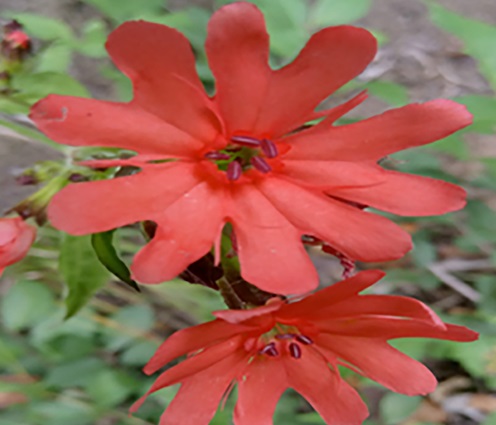

浅裂剪秋萝和丝瓣剪秋萝传粉特性的初步研究

作者简介: 路安民(图中左), 植物系统分类学家。20世纪60-70年代编著《中国植物志》等, 后从事植物系统发育和进化研究。“七五”以来主持了4项中科院、国家自然科学基金委重大和重点项目。1991年获国务院颁发的有突出贡献科学家荣誉证书。1987年8月-1990年12月担任中科院植物所所长。
收稿日期: 2017-04-15
录用日期: 2017-12-27
网络出版日期: 2018-11-29
Prelimary Study of the Pollination Biology of Lychnis cognata and L. wilfordii
† These authors contributed equally to this paper
Received date: 2017-04-15
Accepted date: 2017-12-27
Online published: 2018-11-29
为了探究浅裂剪秋萝(Lychnis cognata)和丝瓣剪秋萝(L. wilfordii)的传粉生物学特征, 从花部特征、花粉呈现规律及传粉者访花行为等方面对其开展研究。结果表明, 2种剪秋萝的花期持续时间相近, 但浅裂剪秋萝始花日期较早; 二者花部特征虽有显著差异, 但主要传粉者均为碧翠凤蝶(Papilio bianor)。在开花过程中, 2种剪秋萝的雄蕊均分2批呈现花粉, 第1批雄蕊的花粉生活力在开花后第1天达到最大值, 而第2批雄蕊在第2天达到最大值。浅裂剪秋萝的柱头可授性在开花后第5天最强, 而丝瓣剪秋萝在开花后第4天最强, 花粉生活力和柱头活性的时间差异表明两物种均为雌雄异熟。两物种共同的传粉者碧翠凤蝶对浅裂剪秋萝的访花高峰出现在上午8:00-11:00, 而对丝瓣剪秋萝的访花高峰出现在上午11:00-12:00, 导致访花高峰出现差异的主要影响因素可能是生境和花药开裂时间。

包宇 , 乔娅楠 , 闫兴富 , 王灵艳 , 曲文静 , 唐占辉 . 浅裂剪秋萝和丝瓣剪秋萝传粉特性的初步研究[J]. 植物学报, 2018 , 53(5) : 634 -642 . DOI: 10.11983/CBB17084
The aim of this study was to study the pollination biology of Lychnis cognata and L. wilfordii from the aspects floral syndrome, pollen occurrence regularity and pollinator flower-visiting behavior. The floral syndrome of L. cognata and L. wilfordii differed significantly, but the main pollinator of these two species was the same: Papilio bianor. The stamens of the two species shed their pollen in two batches, and the pollen viability of the two batches peaked at different times. The pollen viability of the first batch of the two species peaked on the first day after flowering but that of the second batch on the second day after flowering. The receptivity of the stigma of L. cognata reached the peak on the fifth day after flowering, 1 day later than that of L. wilfordii. Hence, the two species are dichogamous. The flowering period was earlier for L. cognata than L. wilfordii, but the flowering duration of two species was similar. The highest visiting frequency of pollinators to L. cognata was at 8:00 to 11:00 am and to L. wilfordii was at 11:00 to 12:00 am. The important factors influencing the visiting time of pollinators may be habitat environmental factors or time of anther dehiscence.

Key words: pollination biology; Lychnis cognata; L. wilfordii; floral syndrome
| 1 | 邓园艺, 喻勋林, 雷瑞虎, 黄娟, 徐永福, 杨文, 向剑锋 (2009). 油茶的传粉生物学特性. 经济林研究 27, 72-75. |
| 2 | 段友爱, 李庆军 (2008). 少花柊叶传粉生物学的研究. 植物分类学报 46, 545-553. |
| 3 | 冯敏, 顾德峰, 董然, 王阳 (2014). 大花剪秋萝离体快繁技术. 东北林业大学学报 42, 90-93, 103. |
| 4 | 傅沛云 (1995). 东北植物检索表. 北京: 科学出版社. pp. 141-160. |
| 5 | 高江云, 任盘宇, 李庆军 (2005). 姜科、闭鞘姜科植物繁育系统与传粉生物学的研究进展. 植物分类学报 43, 574-585. |
| 6 | 胡适宜 (1993). 植物胚胎学实验方法(一)花粉生活力的测定. 植物学通报 10(2), 60-62. |
| 7 | 黄双全 (2007). 植物与传粉者相互作用的研究及其意义. 生物多样性 15, 569-575. |
| 8 | 黄双全 (2014). 花部特征演化的最有效传粉者原则: 证据与疑问. 生命科学 26, 118-124. |
| 9 | 李新蓉 (2006). 沙冬青属植物繁殖生物学研究. 博士论文. 乌鲁木齐: 新疆农业大学. pp. 73-74. |
| 10 | 刘建华 (2009). 沙生蝇子草雄性先熟及花粉序次呈现的生态适应意义. 硕士论文. 乌鲁木齐: 新疆农业大学. pp. 29-31. |
| 11 | 刘明财, 崔凯峰, 郑明艳 (2004). 长白山野生观赏植物引种与栽培试验. 东北林业大学学报 32(4), 22-28. |
| 12 | 陆时万, 徐样生, 沈敏健 (1991). 植物学(上册)(第2版). 北京: 高等教育出版社. pp. 224-225. |
| 13 | 陆婷, 谭敦炎 (2007). 动物传粉植物花粉呈现时序的进化意义. 生物多样性 15, 673-679. |
| 14 | 萝毅波, 裴颜龙, 潘开玉, 洪德元 (1998). 矮牡丹传粉生物学的初步研究. 植物分类学报 36, 134-144. |
| 15 | 吕文, 刘文哲 (2010). 雄全异株植物瘿椒树(省沽油科)的传粉生物学. 植物学报 45, 713-722. |
| 16 | 任明迅 (2010). 两性花的雄蕊运动: 多样性和适应意义. 植物生态学报 34, 867-875. |
| 17 | 盛连喜, 张吉顺 (2013). 吉林龙湾国家级自然保护区综合科学考察报告. 长春: 吉林科学技术出版社. pp. 1-2. |
| 18 | 唐欣, 李新蓉 (2017). 荒漠孑遗植物裸果木的开花物候特征. 植物学报 52, 487-495. |
| 19 | 唐宇翀 (2015). 金斑蝶成虫访花行为及其访花活动规律. 安徽农业科学 43, 18-19, 48. |
| 20 | 王艳菊 (2006). 剪秋萝离体培养再生体系建立及多倍体诱导研究. 硕士论文. 杭州: 浙江大学. pp. 14-16. |
| 21 | 王英强, 张奠湘, 陈忠毅 (2005). 草豆蔻传粉生物学的研究. 植物分类学报 43, 37-49. |
| 22 | 肖宁, 李旦, 武永明, 曹芹, 夏昶, 张金凤 (2012). 剪秋萝种子催芽及秋水仙碱诱导多倍体研究. 中国农学通报 16, 208-214. |
| 23 | 杨春锋, 郭友好 (2005). 被子植物花部进化: 传粉选择作用的客观评价. 科学通报 50, 2575-2582. |
| 24 | 庾晓红, 萝毅波, 董鸣 (2008). 春兰(兰科)传粉生物学的研究. 植物分类学报 46, 163-174. |
| 25 | 张文标, 金则新 (2008). 濒危植物夏蜡梅(Sinocalycanthus chinensis)的开花物候与传粉成功. 生态学报 28, 4037-4046. |
| 26 | 郑荣倩, 候真珍, 张爱勤 (2016). 早春短命植物黑鳞顶冰花的花粉呈现时序及其适应性. 植物学报 51, 594-600. |
| 27 | 朱兴福 (2009). 同域分布的偏花报春和海仙报春的传粉生态学研究. 硕士论文. 兰州: 兰州大学. pp. 21-23. |
| 28 | Aronne G, De Micco V, Scala M (2006). Effects of relative humidity and temperature conditions on pollen fluorochromatic reaction of Rosmarinus officinalis L.(Lamia- ceae). Protoplasma 228, 127-130. |
| 29 | Barrett SCH (2002). Sexual interference of the floral kind.Heredity 88, 154-159. |
| 30 | Cruden RW (1977). Pollen-ovule ratios: a conservative indicator of breeding systems in flowering plants.Evolution 31, 32-46. |
| 31 | Dafni A (1992). Pollination Ecology: A Practical Approach. Oxford: Oxford University Press. pp. 1-57. |
| 32 | Harder LD, Thomson JD (1989). Evolutionary options for maximizing pollen dispersal of animal-pollinated plants.Am Nat 133, 323-344. |
| 33 | Harder LD, Wilson WG (1994). Floral evolution and male reproductive success: optimal dispensing schedules for pollen dispersal by animal-pollinated plants.Evol Ecol 8, 542-559. |
| 34 | Henning T, Weigend M (2012). Total control-pollen presentation and floral longevity in Loasaceae (Blazing Star Family) are modulated by light, temperature and pollinator visitation rates.PLoS One 7, e41121. |
| 35 | Li QJ, Xu ZF, Kress WJ, Xia YM, Zhang L, Deng XB, Gao JY, Bai ZL (2001). Pollination: flexible style that encourages outcrossing.Nature 410, 432-432. |
| 36 | Richardson TE, Stephenson AG (1989). Pollen removal and pollen deposition affect the duration of the staminate and pistillate phases in Campanula rapunculoides. Am J Bot 76, 532-538. |
| 37 | Thomson JD, Thomson BA (1992). Pollen presentation and viability schedules in animal-pollinated plants: consequen- ces for reproductive success. In: Wyatt R, ed. Ecology and Evolution of Plant Reproduction, New York: Chapman & Hall Press. pp. 1-24. |
| 38 | Thomson JD, Wilson P, Valenzuela M, Malzone M (2000). Pollen presentation and pollination syndromes, with special reference to Penstemon. Plant Spec Biol 15, 11-29. |
| 39 | Wang Y, Meng LH, Yang YP, Duan YW (2010). Change in floral orientation in Anisodus luridus(Solanaceae) protects pollen grains and facilitates development of fertilized ovu- les. Am J Bot 97, 1618-1624. |
/
| 〈 |
|
〉 |